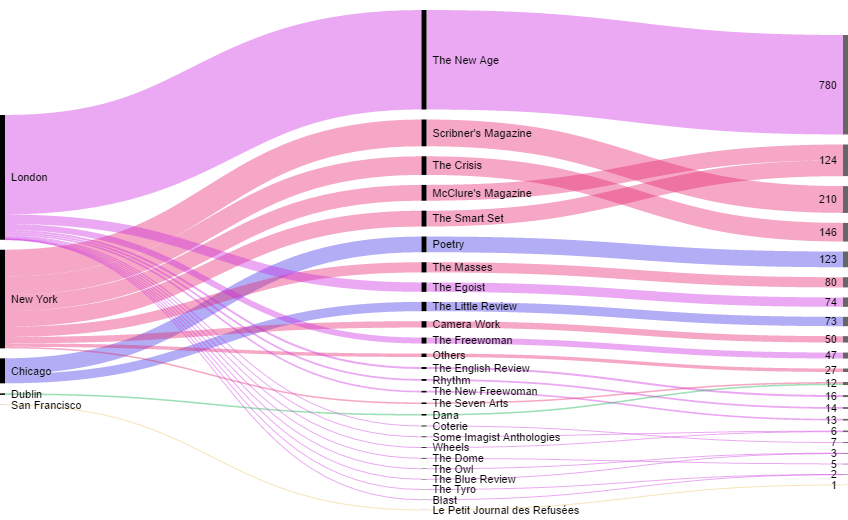This graph most directly demonstrates the places of publication of the magazines in our dataset, alongside the number of issues published by each magazine. It aims to visually categorize the magazines according to place of publication and size. Where were the literary hubs of the Modernist Journal movement, and how did that space inflect their conversations, longevity, and influence? A wide question, to be sure, but hopefully one that our graph investigates -with some surprising results. In this dataset, comparing both size and city of origin is less an ascertainment of correlation, or even causation. Instead, we sought to obtain a clearer perspective on the dynamic geopolitical space inhabited by these journals and their polemic writers. By grouping them according to location, as on the left side of the graph, we can easily compare the number of publications produced by each city, and therefore link this knowledge to the historical contexts of the conversations and socio-political movements they bolstered. Unsurprisingly, the dominant hubs of London and New York produced the largest volumes of work, with Chicago in third place, and finally with San Francisco and Dublin contributing each a small fraction. Our graph hopes to present the immediate geography and robustness of the Modernist Journals to the reader, allowing them to fill those times and places with extraneous context. Moreover, it cautions against a simplistic reduction yoking size and influence together, as we shall soon explore.
By displaying the magazines according to number of issues, as on the right side of the graph, the reader can clearly recognize the longevity of some of these magazines, and compare the relative lifespan and robustness of different publications. The odd numeric sequence on the right hand side of the graph indicating the number of issues published attests to the fact that multiple magazines had the same number of issues. The program we used places them according to the sum of their issues. This accounts for the crossing over of certain strands, as well. Amongst the most voluminous and long-lived journals of the time, The New Age, might immediately strike the reader as a mammoth of its time and place. Should we then assume The New Age dominated its spheres in relation to its smaller neighbors on the graph? We must, however, caution against a simplistic causal summary of the data. This graph primarily serves a sort of mental gatekeeper–letting the reader quickly grasp these geopolitical contexts based on their previous knowledge and complementary primary sources (like the journals themselves), and linking that to the vibrancy these contexts enhanced. After all, the vast majority of publications arise in traditional literary hubs; San Francisco and Dublin contribute one journal apiece, while London boasts a dozen in its fold. Judging by the math, the most prolific magazines, producing 150 volumes or more, appear exclusively in the two dominant hubs (compare that to the 1 issue of the lone San Francisco journal).
But longevity and popularity are not the same things. Indeed,the graph does not account for the relative popularity or influence of the different journals, or the average length of each journal’s issues. It only shows the number of issues published, not how many issues were circulating, or how many of the works originally published in these magazines have since been republished and distributed, such as James Joyce’s novel Ulysses. Similarly, the journals we surveyed in earlier research vary widely in scope and length; some amount to small anthologies of Modernist literature, while others appear as sleek periodicals, perhaps designed to quickly disseminate the avant garde of the avant garde.
Finally, we were surprised that some of the more influential magazines, such as the Little Review and The Crisis, were relatively small, publishing far fewer issues throughout the years than giants such as The New Age. It would seem that while a journal’s geography might correlate to its literary productivity, its literary productivity is not indicative of its ultimate influence. Of course, judging the criteria to measure a journal’s influence itself is a task to which this graph is wholly unsuited. In short, a value judgement must be imposed, framed in the historical context embedded in the texts, or provided in external primary sources. Indeed, the graph also offers fewer insights into understanding the reception of the magazines. Historical accounts and records, however, remind us that their content spanned the width from experimental poetry to scandalous controversy –the journals were often seized by their respective governments (such as The Little Review). In short, we hope to use our graph as a quick and approachable visual gatekeeper, that can direct the curiosity of the reader to other wings of our project, or to historical contexts they themselves are familiar with. Moreover, in the brackets our research, it cautions readers against easy categorizations or faulty correlations, especially between size and influence.
Again, we must stress the seminal nature of many journals. Short-lived journals often went on to provide hotbeds for new ideas, writers, and scandal, whose effects long outlived the presses that birthed them. Similarly, we can see the global, simultaneous, and intellectually vibrant lines of publication scattered across both sides of the Atlantic: this was an expressly global movement.

